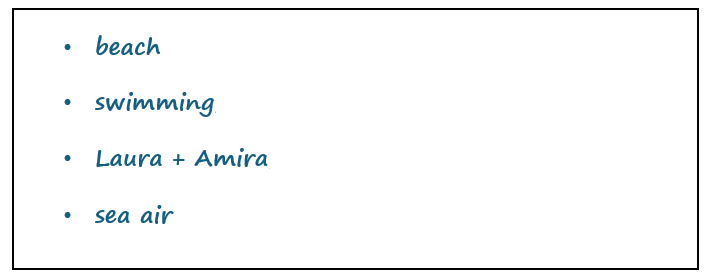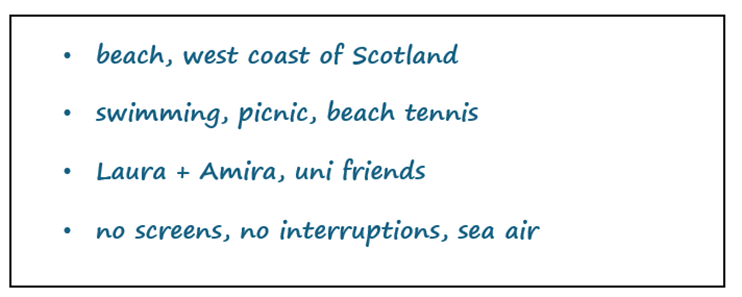- Aug 31, 2024
IELTS Speaking Test Fluency Tips - Part 2
In the first blog of this series we looked at what is meant by ‘fluency’ and how to boost your fluency band score in Speaking Part 1.
This second blog looks at how you can approach the challenge of the long turn of Speaking Part 2 in a way that helps you keep speaking for the full two minutes in a fluent and coherent way.
The challenge of speaking for 2 minutes
The main issue for a lot of test takers in Speaking Part 2 is simply being able to speak for the full time allocated - two minutes. Consider how that might affect your fluency band score , in particular, in this specific area:
“Able to keep going and demonstrates a willingness to produce long turns.”
The most straightforward reason for not being able to keep going is simply not having enough to say. We see this happen all of the time with students and test takers who don’t make the most of the one-minute preparation time. Look at the notes for the topic card below, do you see the problem? While the examiner is listening to see how fully you meet this point throughout the Speaking Test, in Part 2 it becomes a lot more evident. As you are speaking alone for two minutes during the long turn, the examiner is able to assess how fully you meet this part of the criteria, how able you are to keep going. Like the river or waterfall we saw in Part 1, this time you will keep going until the examiner stops you by rounding it up and moving onto Part 3.
Running out of things to say
The most straightforward reason for not being able to keep going is simply not having enough to say. We see this happen all of the time with students and test takers who don’t make the most of the one-minute preparation time. Look at the notes for the topic card below, do you see the problem?


While the test taker is absolutely prepared to answer all the prompts on the topic card, these notes are not going to provide them with enough to say to be able to keep going for the full time allocated. Try using the notes now. How long did you speak for?
What tends to happen then is you might realise you still have a lot of time left and try to fill the time by just adding unnecessary or irrelevant details at the end of your story or jumping back to fill in details that could have been mentioned earlier. This not only affects your fluency but can also impact how coherent your answer actually is!
So how can you avoid this?
Begin with detail, expand and describe
Begin with detail
Start your response in a detailed and interesting way by ‘setting the scene’ a little more. Listen to the beginning of this example response to the question. What has the speaker done to ‘begin with detail’? Listen to the start of a response.
Did you notice that the test taker avoided simply jumping into the answers to the prompts by adding a little bit of background information about the story? Try doing this in your own responses, set the scene for the listener, the examiner, by introducing your response in an interesting and descriptive way.
Expand
For each of the prompt points on the topic card, try to provide at least two items of information
For example:

The prompts that are provided on the topic card are there to help you but avoid answering them with just one-word responses, expand your answers to each prompt by adding more factual information in your notes.
Describe
As you are thinking of the ‘facts’ of the story, also try to paint a picture a little bit more by adding description wherever possible.
For example:

Not only is this to help you reach the two minutes of speaking time, but think about how we naturally tell stories to our friends and family. We always use descriptive language when we’re telling stories, because we want to make them interesting. The IELTS test should be no different. Make your story an interesting one to listen to by adding in some description as you go.
Practise preparing and using your notes
For most IELTS test takers, speaking uninterrupted, alone, for two minutes feels a bit strange, unless you’ve had plenty of practice. So between now and your test day, look at the example questions provided by IELTS and in our own Speaking lesson pack and try to write fully-expanded, descriptive notes. Record yourself giving full responses which ‘set the scene’ for the listener by adding detail from the beginning, expand on each of the prompts with at least two items of information, and provide a description that helps to ‘paint a picture’ for the listener.
Why not check out our on-demand IELTS Speaking Pack and get access to our webinar lessons to learn more about improving you band score in Fluency and Coherence and Lexical Resource?
3 comments

I’ve shared this with my IELTS students, aiming for a Band 7.

Thanks, your blogs and training videos have been such a great support for my teaching. I’ve shared Team IELTS with my students who love it! Keep it coming!

Very helpful tips, the long turn is an area that students often struggle with